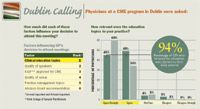Global Education
It's clear CME is becoming an important part of global healthcare, and there's no better time for pharma companies to capitalize on this growing trend. There's enormous opportunity, but it must be tailored to the distinct clinical environment of each country.
Accredited continuing medical education programs in the United States have improved over the years with the support of medical education providers and medical technology companies. But throughout the rest of the world, CME support systems are not as widespread.
In much of Europe, formal CME programs have been available only since the early 1990s, though they are likely to catch up to US programs in quantity and quality within the next 10 years, thanks to continued progress in healthcare quality, program financing, and means of measuring CME outcomes.
CME support systems worldwide are progressing. In 1993, the European Union for Medical Specialists (UEMS), the umbrella organization for physicians in the European Union and associated countries, began to focus on CME activities. And even more recently, in 2000, the UEMS established the European Accreditation Council for Continuing Medical Education (EACCME) to serve as a clearinghouse for accreditation among national CME regulatory bodies.
It's clear that CME is becoming an increasingly important part of global healthcare, and there's no better time for pharma companies to capitalize on this growing trend. Our research shows that European doctors are motivated by the challenge of learning and keeping up-to-date with new information in their specialty areas. They realize continuing education is essential to achieving better treatment outcomes. There's an enormous opportunity, but for CME to influence patient care and treatment outcomes worldwide, it must be tailored to the distinct clinical environment of each country.
Status Quo
In the United States, CME programs are promoted and created by large medical societies, academic institutions, and independent, accredited organizations that design programs to meet physicians' needs. Overseas, things are more complicated. CME programs are handled largely by not-for-profit organizations that include medical societies, patient or advocacy groups, and government agencies. And because doctors practice under different systems from country to country, there are a variety of accreditation and treatment-delivery methods, and prescribing patterns. Here are some of the ways CME procedures are different overseas:
Unified approach Due to distinct national agendas, no single organization has emerged to create a unified approach to accreditation. The closest approach to a standards organization is the EACCME, which was set up to create a CME standard throughout the European Union and harmonize member-state education policy. The national regulatory bodies of each EU member state approve the accreditation of programs and events, and the EACCME acts as a liaison to ensure that awarded credits transfer within European countries. One setback is that not all countries participate in the mutual recognition process, which makes it difficult to create a unified code of accreditation. In fact, each country has its own set of rules for CME and obtaining credit (see, "Going Global").

Going Global
Creating content In the United States, pharma companies are required to use third parties to create content for education programs, as regulated by the Accreditation Council for Continuing Medical Education. In Europe, however, pharma companies can actually create their own CME content on a proprietary basis. Activity is still very highly regulated and content has to be accredited by an authorized agency, but there remains a level of freedom that does not exist in the United States.
Culture It's nearly impossible to take the CME content that's used in the United States and apply it to countries abroad. The systems and overall programs, however, are transferable. Research has shown that physicians globally are looking for content that is relevant to their practices and does not provide added cost or time pressure. They also want to learn from experts on the local level.
But often the words don't translate and the meaning gets lost. CME providers need to take a look at cultural landscapes to understand nuances; what may appear to be quaint local habits are actually crucial details when creating program agendas. For example:
- In the United Kingdom, each independent country—England, Scotland, and Wales—has its own cultural and treatment protocols; format and channel can remain, consistent but content must differ.
- Irish doctors are highly compensated, which gives them a certain status in society; it's harder to get them to attend CME programs.
- The Japanese experience the longest life expectancy in the world, but they also have very high stress levels; programs should be tailored to address this condition.
A distinction that exists between US and European doctors is that European doctors tend to respond more readily to program confirmations. If they are reminded of the program and cannot attend, they will inform organizers promptly—in contrast to some US doctors who don't respond at all.
Put It to Use
Physician research demonstrates that faculty, relevance of topics to their practice, and access to education are key criteria in a physician's decision to choose an educational program (see "Dublin Calling"). Research also shows that time and cost are the greatest barriers to attendance. To understand what specific drivers cause physicians to participate in continuing education programs, providers should collaborate with local experts.

Dublin Calling
Advisory boards One of the ways CME companies develop needs assessments is by reaching out to local health service organizations and medical societies. In-country expertise helps providers produce high-quality education programs that are tailored to individual nations. It is vital to understand physician behavior on a national and regional level to assure that educational programs enhance and improve patient care.
To find out what the local differences are, CME providers in Europe collaborate with advisory boards, which usually include representatives from medical societies, government agencies, and faculty. These boards provide insight into physician-learning preferences, timely topics, and governmental policies that have a direct impact on educational programs.

Dublin Calling
Accreditation and funding Pharma companies can directly fund CME programs in other geographies, and will often use national key opinion leaders to develop content for the activities. For the most part, the government bodies in Europe do not set educational curriculums, but there are some cases in which it can set up agendas through clinical guidelines. For example, in 2004, the UK government set up a national service framework that emphasized diabetes awareness. The government there cannot control which disease categories are addressed in CME programs, but it can influence which areas are made high priority. In 2005, it set up a framework that pushed obesity awareness.
Accessibility CME programs must meet all doctors' needs, which means the programs cannot be limited to capital cities like Paris, London, and Dublin. Although it makes sense to set up CME in cities that contain a large number of doctors, it doesn't mean smaller cities should be ignored. As discussed earlier, two major barriers to physician participation are time and expense, so physicians should not have to travel far from home to learn from experts in their fields. If providers make CME substantially more accessible for doctors, participation and quality of education will increase.
Groups that pharma companies should get to know when setting up CME programs abroad include government or regulatory agencies, medical societies, and key opinion leaders. Building these relationships requires investment in local expertise and local offices within each country. Whatever the structural of cultural differences in healthcare might be, education in all countries must adhere to strict standards of scientific rigor, evidence-based medicine, and objectivity.
John Sheehan is executive vice president of M/C Communications, the parent company of Pri-Med. He can be reached at jsheehan@mc-comm.com
New Insights Into T Cell Exhaustion and Inflammation in Long COVID
April 17th 2025Nigel McCracken, chief operating officer, Virax Biolabs, discusses new findings that reveal altered cytokine activity and evidence of T cell exhaustion in long COVID patients, providing deeper insight into post-infection immune disruption.
Addressing Disparities in Psoriasis Trials: Takeda's Strategies for Inclusivity in Clinical Research
April 14th 2025LaShell Robinson, Head of Global Feasibility and Trial Equity at Takeda, speaks about the company's strategies to engage patients in underrepresented populations in its phase III psoriasis trials.
Beyond the Prescription: Pharma's Role in Digital Health Conversations
April 1st 2025Join us for an insightful conversation with Jennifer Harakal, Head of Regulatory Affairs at Canopy Life Sciences, as we unpack the evolving intersection of social media and healthcare decisions. Discover how pharmaceutical companies can navigate regulatory challenges while meaningfully engaging with consumers in digital spaces. Jennifer shares expert strategies for responsible marketing, working with influencers, and creating educational content that bridges the gap between patients and healthcare providers. A must-listen for pharma marketers looking to build trust and compliance in today's social media landscape.
